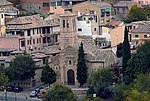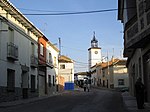Church of San Andrés, Toledo
12th-century Roman Catholic church buildings in SpainBien de Interés Cultural landmarks in the City of ToledoFormer mosques in SpainGothic architecture in Castilla–La ManchaMudéjar architecture in Castilla–La Mancha ... and 3 more
MummiesRoman Catholic churches in Toledo, SpainVisigothic architecture

The Church of San Andrés (Spanish: Iglesia de San Andrés) is a Catholic church located in the city of Toledo, in Castile-La Mancha, Spain. The building is of medieval origin, and as is common in this city, is a mix of different styles. It is protected by the heritage listing Bien de Interés Cultural.
Excerpt from the Wikipedia article Church of San Andrés, Toledo (License: CC BY-SA 3.0, Authors, Images).Church of San Andrés, Toledo
Plaza de San Andrés, Toledo
Geographical coordinates (GPS) Address External links Nearby Places Show on map
Geographical coordinates (GPS)
| Latitude | Longitude |
|---|---|
| N 39.8545 ° | E -4.0241 ° |
Address
Iglesia de San Andrés
Plaza de San Andrés
45002 Toledo
Castile-La Mancha, Spain
Open on Google Maps











